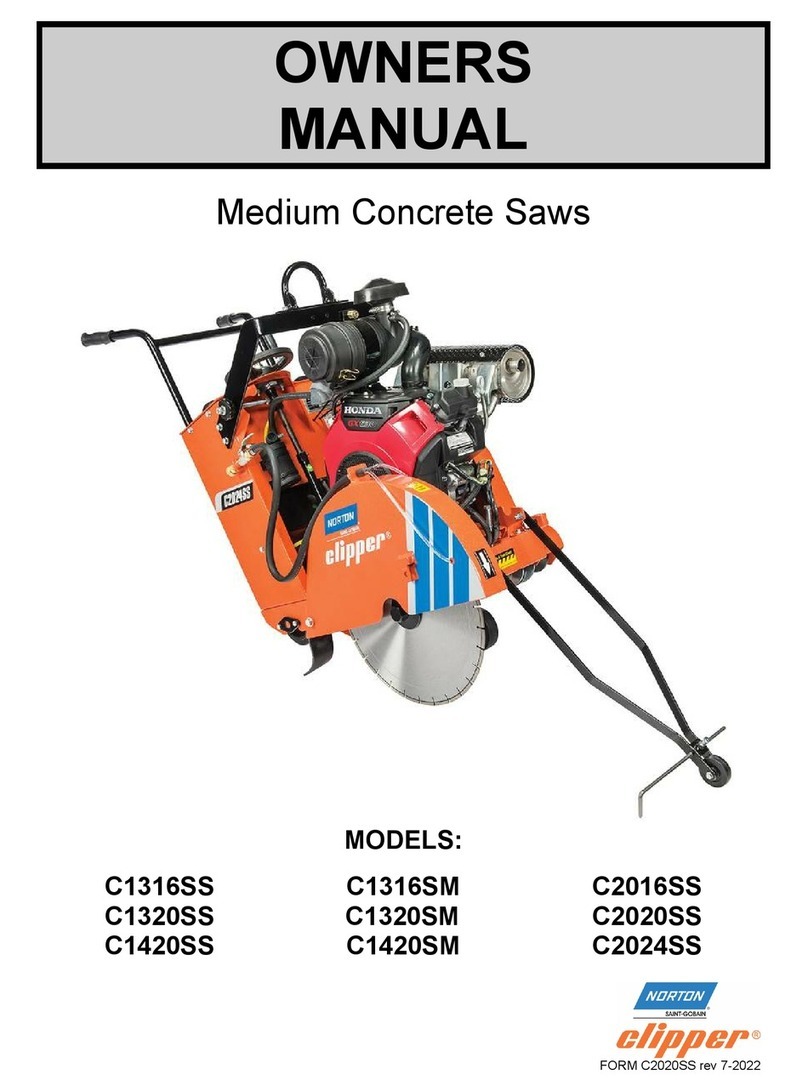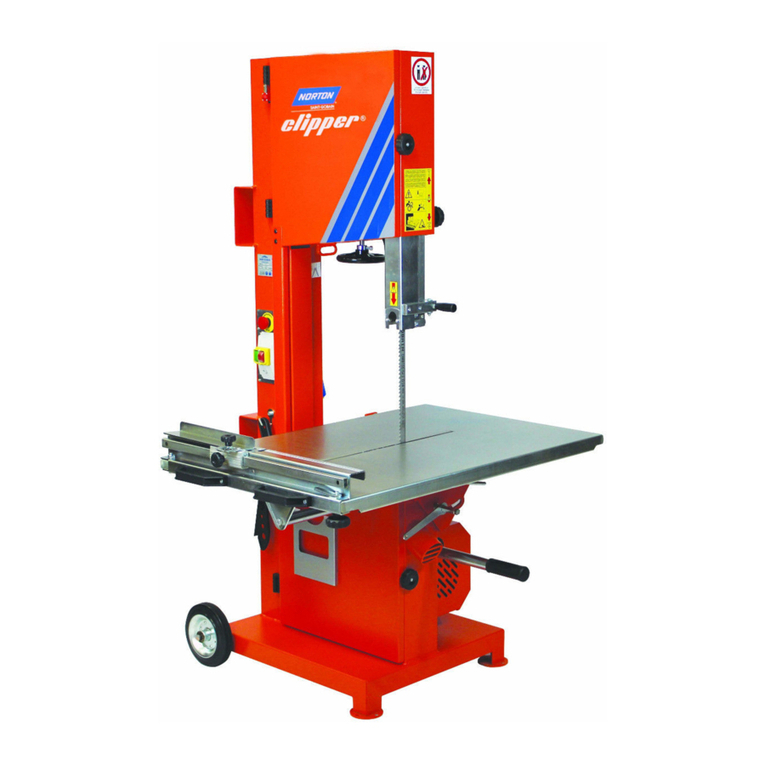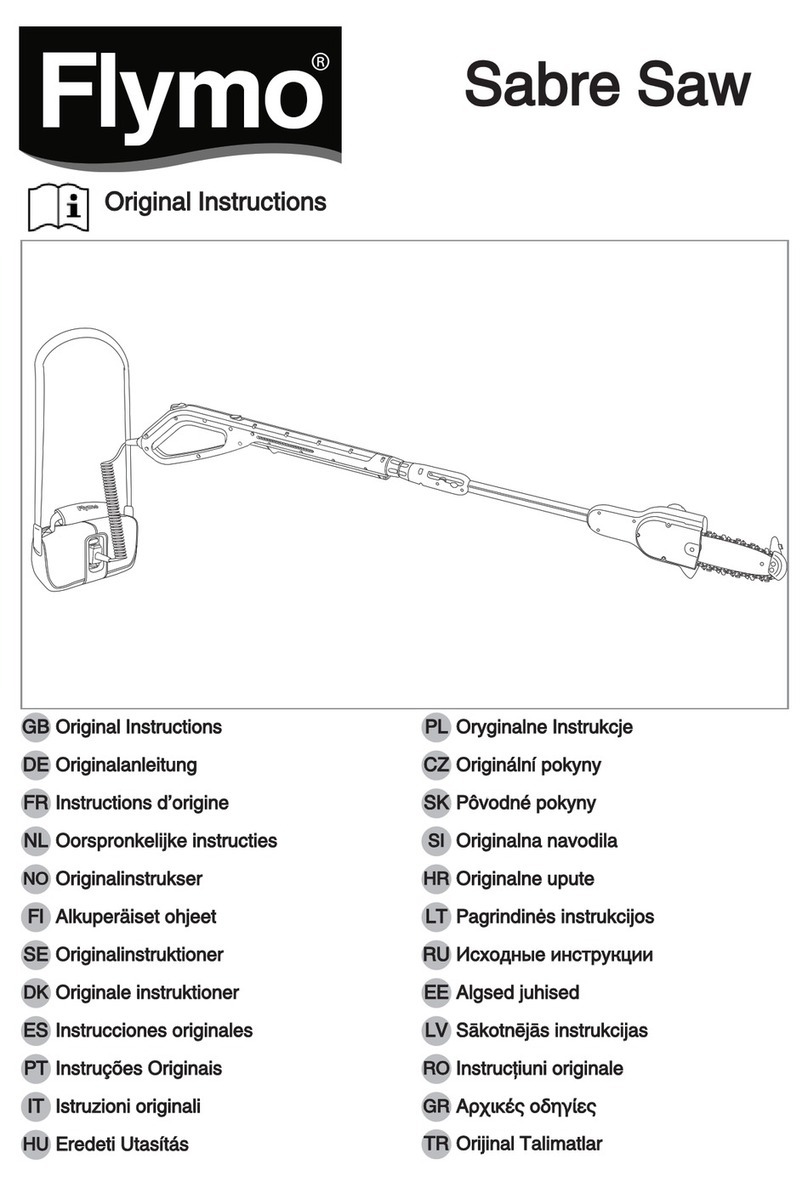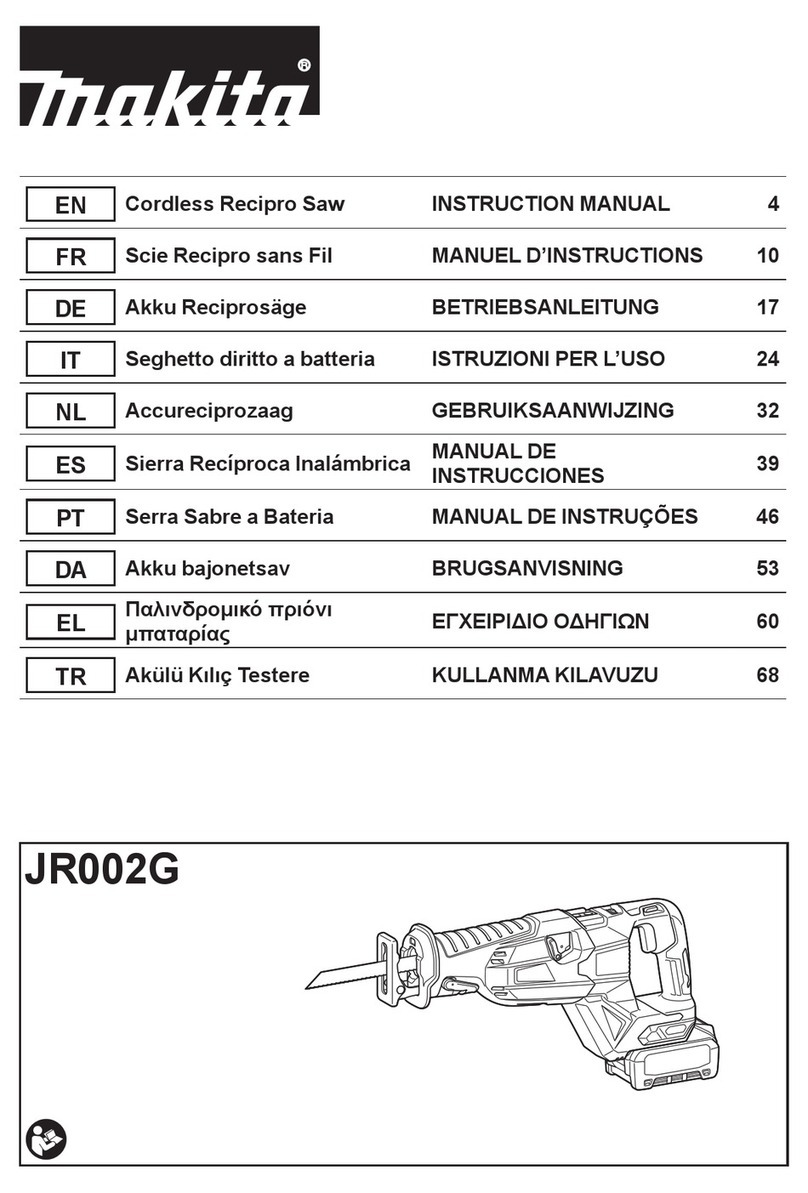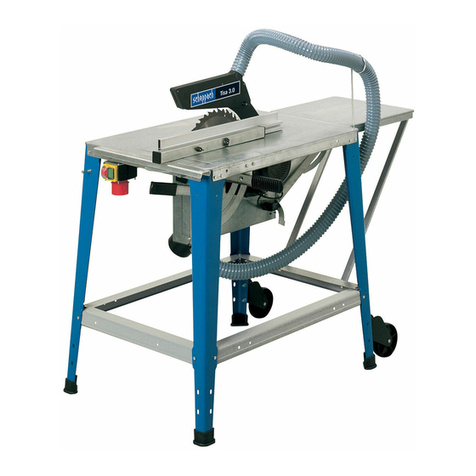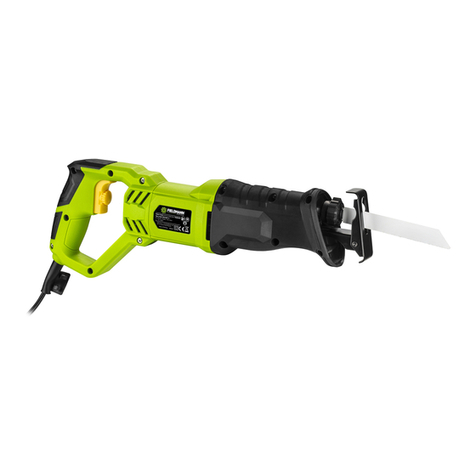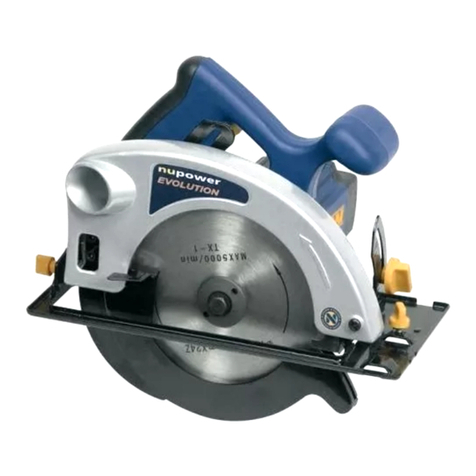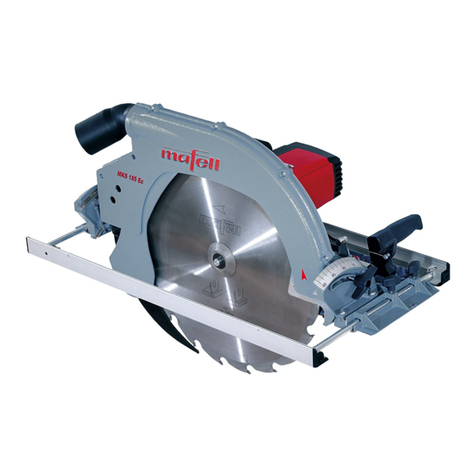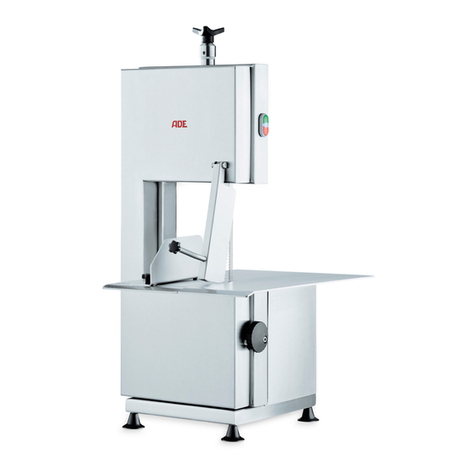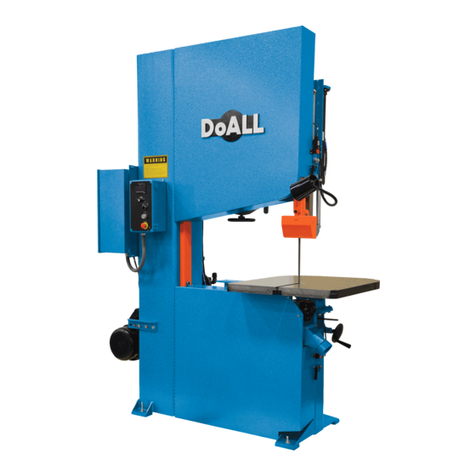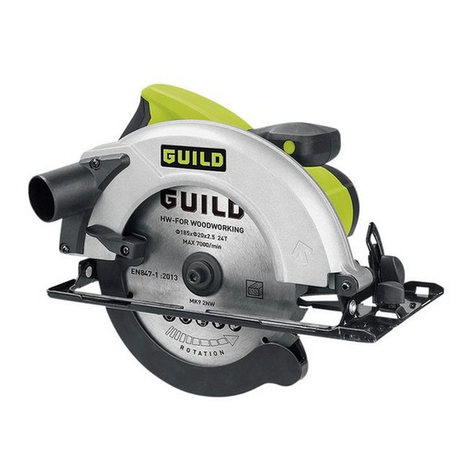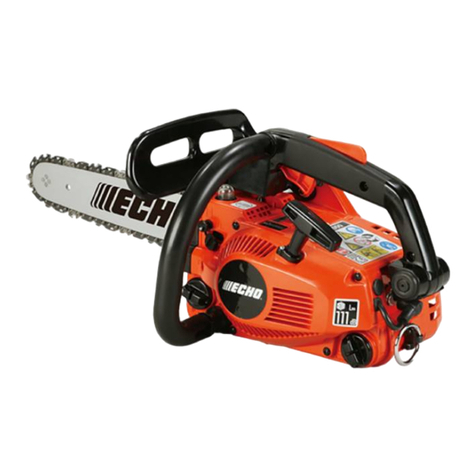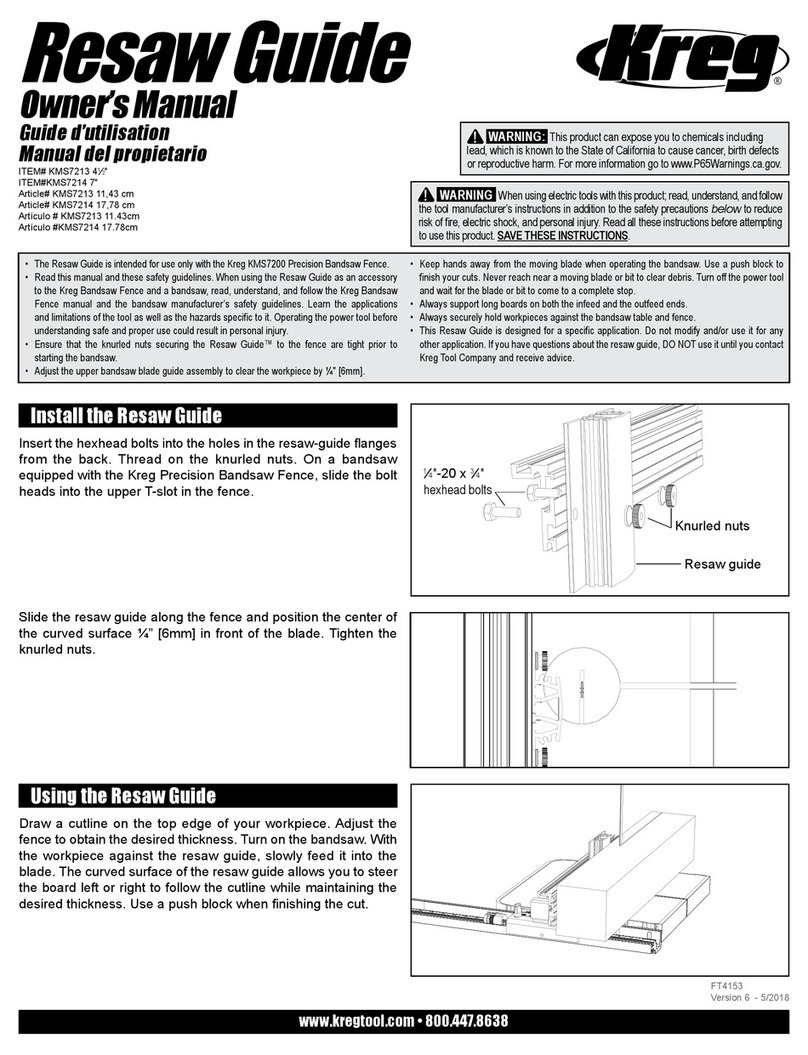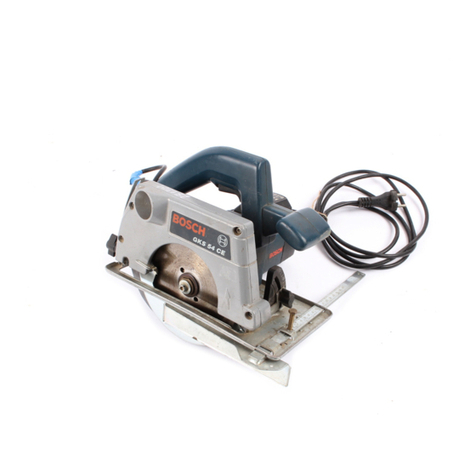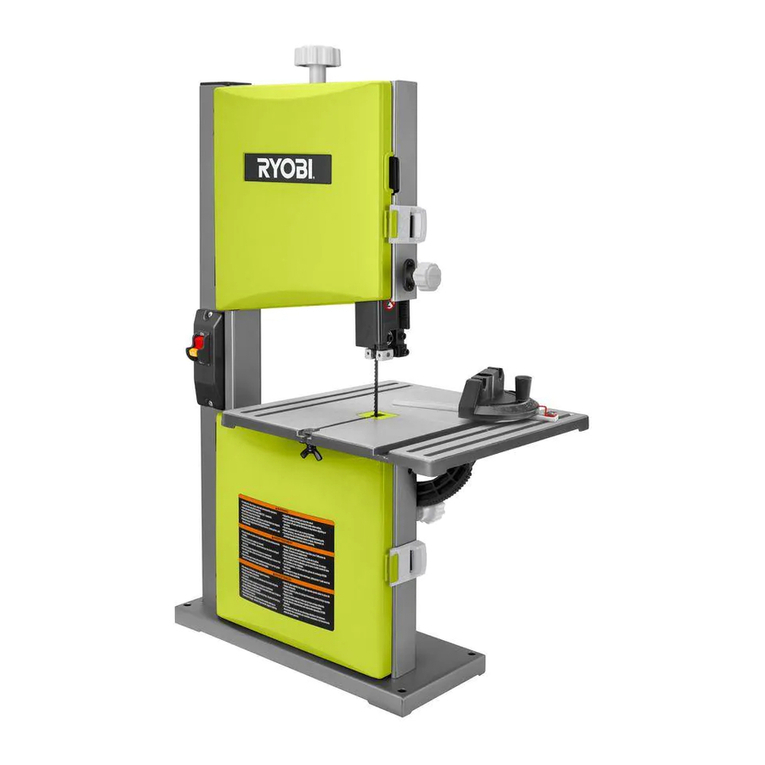Norton Clipper CM 41 User manual

CM 41
OPERATING INSTRUCTIONS

2

3
The undersigned manufacturer:
SAINT - GOBAIN ABRASIVES S.A.
190, BD J.F. KENNEDY
L- 4930 BASCHARAGE
Declares that this product:
Masonry Saws: CM 41 Code: 70184628167
Code: 70184642281
Code: 70184628645
is in conformity with the following Directives:
European Machinery Directive 2006/42/EC
“LOW VOLTAGE" 2006/95/EC
Electromagnetic Compatibility Directive 2004/108/EC
and European standard:
EN 12418 –Masonry and stone cutting-off machines –Safety
Declaration of conformity

4

5
CM 41
OPERATING INSTRUCTIONS
TABLE OF CONTENTS
1Basic Safety Instructions 6
1.1 Symbols 6
1.2 Machine plate 7
1.3 Safety instructions for particular operating phases 7
2Machine description 8
2.1 Short description 8
2.3 Layout 8
2.4 Technical Data 10
3Assembly and commissioning 11
3.1 Tool assembly 11
3.2 Conveyor cart and handle assembly 11
3.3 Electrical connections 11
3.4 Starting the machine 11
3.5 Water cooling system 12
4Transport and storing 13
4.1 Securing for transport 13
4.2 Transport procedure 13
4.3 Long period of inactivity 13
5Operating the machine 14
5.1 Site of work 14
5.2 Cutting methods 14
6Maintenance and servicing 16
7Faults: causes and cures 17
7.1 Fault-finding procedures 17
7.2 Trouble-shooting guide 17
7.3 Circuit diagram 18
7.4 Customer service 20

6
1 Basic Safety Instructions
The CM 41 is exclusively designed for the cutting of construction products mainly on construction
sites.
Uses other than the manufacturer's instructions shall be considered as contravening the regulations.
The manufacturer shall not be held responsible for any resulting damage. Any risk shall be borne
entirely by the user. Observing the operating instructions and compliance with inspection and
servicing requirements shall also be considered as included under use in accordance with the
regulations.
1.1 Symbols
Important warnings and pieces of advice are indicated on the machine using symbols. The following
symbols are used on the machine:
Read operator’s instructions
Ear protection must be worn
Hand protection must be worn
Eye protection shall be worn
Rotation direction of the blade
Danger: risk of cut

7
1.2 Machine plate
Important data can be found on the following plate located on the machine:
1.3 Safety instructions for particular operating phases
Before commencing work
Before commencing work, make yourself familiar with the working environment at the place of
use. The working environment includes: obstacles in the area of work and manoeuvre, the
firmness of the floor, necessary protection at the site relating to public thoroughfares and the
availability of help in the event of accidents.
Check for correct mounting of the blade regularly.
Immediately remove damaged or badly worn blades, as they endanger the operator whilst
rotating.
Only fit NORTON diamond blades to the machine! The use of other tools can damage the
machine!
Attention is drawn to the use of BS2092 safety goggles in conformity with specified Processes
No.8 of the Protection of Eyes Regulation 1974, Regulation 2(2) Part 1.
For security reasons, never leave the machine unattended, untied or unlocked.
While the engine is running
Do not move the machine whilst the blade is running idle.
Always cut with the blade guard in position.
Apply cooling water continuously whilst cutting and in good time!
Petrol powered machines:
Always use the fuel advised.
In confined areas, exhaust gases should be evacuated and the job site properly aerated.
Petrol and diesel machines, which by their nature emit toxic exhaust gases, must not be used in
places prohibited by the Health at Work etc. Act 1974 or which are prohibited by Factory
Inspectors or Safety Officers.
Fuel is flammable. Before filling the tank, shut down the engine, extinguish all open flames and
do not smoke. Take care that no petrol is spilled on any motor part. Always wipe up spilled fuel.
Machine Model
Machine Code
Weight
Year of production
Maximum blade diameter
Machine type
Serial number
Power
Safety standard
Blade speed
Bore diameter

8
2 Machine description
Any modification, which could lead to a change in the original characteristics of the machine, may
be done only by Saint-Gobain Abrasives who shall confirm that the machine is still in conformity with
the safety regulations.
2.1 Short description
The CM 41 Masonry saw is designed for durability and high performance for onsite wet and dry
cutting operations of a wide range of masonry, refractory and natural stone products. As with all
other CLIPPER products, the operator will immediately appreciate the attention given to detail and
quality of materials used in construction. The machine and its component parts are assembled to
high standards assuring long life and minimum maintenance.
2.2 Purpose of use
The machine is designed for wet and dry cutting of a large range of building and refractory
materials, or tiles. It is not designed for cutting wood or metals.
2.3 Layout

9
Frame and feet (1)
The frame is made of a jig-welded reinforced steel construction to ensure perfect rigidity. 4
removable legs fit into housings welded on frame sides and locked into place with wing screws.
Cutting head (2)
Spring loaded jig-welded steel console. The motor fixing points and the pivot are machined for
perfect fit. A locking system allows straight-through cutting without any other accessory.
Blade guard (3)
Jig-welded steel construction with 400mm-diameter blade capacity, which offers maximum operator
protection and increased visibility of the work piece.
Incorporated in the blade guard is an outer metal cover, which can be easily removed to allow easy
access to shaft for inspection and blade replacement when motor is switched off, while fully
protecting the blade when in operation.
Electrical Motor (4)
2,2kW electrical motor with an overload protection. Thermal overload tripping can occur for two
reasons: tripping under light load if connection is incorrect and tripping under heavy load if motor
has been overloaded.
The ON-OFF switch also serves as emergency stop. The pump switch is located on the right side of
the main switch. Low voltage trigger (NVR) built in the switch prevents the motor to restart for
example after a power cut.
Conveyor cart (5)
Steel welded construction with non-slip top. A part of the conveyor cart bed tilts from 0 to 45º for
angle bevel tile cutting.
The machine guide system permits precise cuts to be made by virtue of four roller sheaves set at an
inclination to compensate for wear.
The nylon-plastic sheaves and sealed-bearings permit easy operation. Precise positioning of the
material is possible thanks to the large surface area of the conveyor cart and the variable angle
guide-a-cut.
Water cooling system (6)
The coolant system comprises:
A powerful, submersible electric water pump.
Plastic suction pipe delivering the water from the water pan to the cutting head.
A large capacity water pan supplied with drain plug.
A water-tap, fitted to the blade guard, permitting controlled water flow.
Two water nozzles located on the blade guard ensure adequate flow of water to both sides of
the cutting blade.
A water curtain, fixed to head axle restricts water spray and minimises water loss.
The pump switch is located on the right side of the main switch.
Attention: The water pump must never run without water.

10
2.4 Technical Data
Electric motor
2,2 kW 230V with thermal overload protection
2,0 kW 115V with thermal overload protection
Electric motor protection
IP54
Max. blade diameter
400 mm
Bore
25,4 mm
Rotation speed of the blade
2800 min-1
Flange diameter
90 mm
Cutting depth mm
135 mm (without reversing the material)
Sound pressure level
80 dB (A) (ISO EN 11201)
Sound energy level
92 dB (A) (ISO EN 3744)
Max. cutting length mm
600 mm
Table dimension (L x W)
340x440 mm
Machine dimensions feet folded (L x W x H)
1170x600x740 mm
Machine dimensions feet unfolded (L x W x H)
1170x600x1400 mm
Weights:
Machine complete
85 kg
Ready for use (with water)
120 kg

11
3 Assembly and commissioning
The machine is delivered fully equipped (although without diamond blade). It is ready for operation
when you mount the diamond blade, the handles and the conveyor cart and after you connect to the
appropriate power supply.
3.1 Tool assembly
Only NORTON blades with a maximum diameter of 400 mm can be used with the CM 41.
All tools used must be selected with regard to their maximum permitted cutting speed for the
machine’s maximum permitted rotation speed. Before mounting a new blade into the machine,
switch off the machine and isolate it from the main source of electricity.
To mount a new blade, follow these steps:
Loosen the clamp on the front of the blade guard, disconnect the water hose on the left side of it
and open the blade guard.
Loosen the hexagonal nut on the blade shaft (attention: left threaded), which holds the
removable outer flange.
Remove the outer flange.
Clean the flanges and blade shaft and inspect for wear.
Mount the blade on arbour ensuring that direction of rotation is correct. Wrong direction of
rotation blunts the blade quickly.
Replace outer blade flange.
Tighten hexagonal nut with spanner supplied for this purpose.
Close the blade guard, retighten clamp on the front of the guard and reconnect the water hose.
ATTENTION: The blade bore must correspond exactly to the diameter of the blade shaft. Cracked
or damaged bore is dangerous for the operator and for the machine.
3.2 Conveyor cart and handle assembly
Handle and conveyor cart are located in the water pan.
Place the conveyor cart on the guiding rails with the material stop facing the operator.
Assemble the handles with the supplied M10 nuts and bolts.
3.3 Electrical connections
Check that,
The voltage/phase supply corresponds to the information indicated on the motor plate.
Available power supply must have ground connection in conformity with safety regulations.
The connecting cables should have at least a 2. 5mm2-section per phase.
3.4 Starting the machine
Open the cover on the switch and press the green button to start the machine. Either press on the
red button or directly on the switch cover to stop the machine.

12
3.5 Water cooling system
Fill the water pan with clean water to approximately 2cm from top (ensure that bottom of pump is
fully immersed in water). Use the pump switch on the side of the main switch to start the pump.
Open the water-tap on blade guard (note that handle on water-tap should be in line with water-
flow).
Ensure that water is flowing freely in the circuit and is delivered adequately to both sides of the
blade, as insufficient water supply may result in premature failure of the diamond blade.
The water pump must never run without water. Always make sure that there is enough water in
the pan and refill if necessary.
In case of frost, empty the water cooling system from its water.

13
4 Transport and storing
4.1 Securing for transport
Before transporting the machine, always remove the blade and empty the water pan. Also lock the
conveyor cart, as it can be dangerous while you move the machine.
4.2 Transport procedure
There are two ways to move the machine: By one person, its feet folded and making use of the
transport wheels, our by two persons with its feet folded our unfolded.
Always fold the feet while transporting the machine in a van our truck.
The machine does not have lifting hooks.
4.3 Long period of inactivity
If the machine is not going to be used for a long period, please take the following measures:
Completely clean the machine
Empty the water system
Take the water pump out of the slurry and clean it thoroughly.
The storage site must be clean, dry and at a constant temperature.

14
5 Operating the machine
5.1 Site of work
5.1.1 Siting the machine
Remove from the site anything, which might hinder the working procedure!
Make sure the site is sufficiently well lit!
Observe manufacturer's conditions for connecting to power supplies!
Place electric cables in such a way that damage is excluded!
Make sure you have a continual adequate view of the working area so you can intervene in the
working process at any time!
Keep other staff out of the area, so you can work securely.
5.1.2 Space required for operation and maintenance
Leave 2 m in front of the machine and 1, 5 m around it for usage and maintenance of the CM 41.
5.2 Cutting methods
To use the machine correctly, you must face it with one hand on the handle of the cutting head, and
the other on the conveyor cart. Always keep your hands away from the moving blade. Open the
switch cover and press the green button to start the machine. To stop either use the red button or
press directly on the switch front cover.
5.2.1 Full depth or fixed cutting
In full depth or fixed cutting, the cutting head is locked in a fixed position and the material is pushed
into it as shown.
Lower the cutting head to the desired cutting depth (in “through cutting”, lower cutting head until
blade periphery reaches max. 3mm under the surface of the conveyor cart) by means of the
handle on the blade guard
Fix position by tightening the clamping device
Put material on conveyor cart
Start the machine
Push the conveyor cart slowly and without undue pressure towards the rotating blade and cut
the material as shown on the picture.
NOTE: While recommended, it is not absolutely necessary to lock the cutting head into a given
depth position when jam cutting. The desired cutting depth can be maintained by holding firmly the
depth feed handle on the blade guard. If the full depth of cut requires excessive pressure (on very
dense material e.g.) make 2 or 3 shallow cuts.

15
5.2.2 Multiple step cutting
Multiple step cutting consists of moving the conveyor cart with the material to be cut back and
forward under the rotating blade,
Place the material to be cut on the conveyor cart firmly against the guide-a-cut and the
backstop, keeping the hands well away from the blade.
Start the machine.
Move conveyor cart forward near the blade and pull down the cutting head until blade is lowered
to a point where it will lightly contact the surface of the material.
Pass the material beneath with rapid full length strokes, taking a shallow cut (approximately 3
mm deep as shown on the picture) on the forward. On the backward stroke, lift the blade just
clear over the cutting line.
Complete each rapid stroke backward and forward by passing the material beyond the centre of
the blade before starting the reverse movement of the conveyor cart.
NOTE: the harder the material, the more rapid should be the forward and backward strokes.
Step cutting lessens the area of the blade circumference in contact with the material, keeping the
blade cool, running free and cutting at peak efficiency.
5.2.3 General advice for the cutting
Material weight under 40 kg and having dimensions smaller than 600x500x135mm can be cut
with the machine.
Before commencing work make sure tools are firmly seated!
Select the right tools as recommended by the manufacturer depending on the material to be
worked, the working procedure (dry or wet cut) to be carried out and the required efficiency.
Apply cooling water continuously whilst cutting and in good time! Make sure the water pan
contains enough water.
When dry cutting, ensure sufficient dust extraction and wear a dusk protection mask!
When cutting work is finished, close the water-tap so you can remove the cut pieces from the
conveyor cart without getting wet.
In case the thermal protection trips, wait until the motor has cooled down before starting the
machine again.

16
6 Maintenance and servicing
To ensure a long-term quality from the cutting with the CM 41, please follow the maintenance plan
below:
Begin of the day
During the changing of tool
End of the day
or more often if required
Every week
After a fault
After a damage
Whole machine
Visual control (general aspect,
water tightness)
Clean
Flange and blade fixing devices
Clean
Motor cooling fans
Clean
Water pump
Clean
Water pan
Clean
Water hoses and nozzles
Clean
Water pump filter
Clean
Cart guiding bars
Clean
Motor housing
Clean
Reachable nuts and screws
Tighten up
Maintenance of the machine
Always perform the maintenance of the machine with the machine isolated from the electrical
supply.
Lubrication
The CM 41 uses life-lubricated bearings. Therefore, you don’t need to lubricate the machine at all.
Cleaning of the machine
Your machine will last longer if you clean it thoroughly after each day of work, especially water
pump, water pan (which can be removed for easy cleaning), motor and blade flange.

17
7 Faults: causes and cures
7.1 Fault-finding procedures
Should any fault occur during the use of the machine, turn it off, and isolate it from the electrical
supply. Any works dealing with the electrical system or supply of the machine can only be carried
out by a qualified electrician.
7.2 Trouble-shooting guide
Trouble
Possible source
Resolution
Motor is not running
No electricity
Check the electrical supply
(fuse for example)
Connection cable section too
small
Change connection cable
Defective connection cable
Change connection cable
Defective switch
CAUTION : can only be solved
by qualified electrician
Defective motor
Change motor or contact motor
manufacturer
Motor stops during the cutting,
but can be restarted after a
short period (overload
protection)
Cutting advance too quick
Cut slowly
Blade is blunt or glazed
Sharpen the blade in
calcareous stone
Defective blade
Change blade
Wrong blade specification for
the application
Change blade
No water on the blade
Not enough water in the pan
Refill the water pan
Water pump is switched off
Switch the water pump on
Water tap is closed
Open tap on blade cover
Water supply system is blocked
up
Clean water supply system
Water pump is not working
Prime the pump
Reactivate switch
CAUTION : if switch trips again,
problem can only be solved by
a qualified electrician

18
7.3 Circuit diagram
230 V

19
115V

20
7.4 Customer service
When ordering spare parts, please mention:
The serial number (7 digits).
The code of the part.
The exact denomination.
The number of parts required.
The delivery address.
Please indicate clearly the means of transportation required such as "express" or "by air".
Without specific instructions, we will forward the parts through the means which seem
appropriate to us --- but which is not always the quickest way.
Clear instructions will avoid problems and faulty deliveries.
If not sure, please send us the defective part.
In the case of a warranty claim, the part must always be returned for evaluation.
Spare parts for the motor can be ordered with the manufacturer of the motor or with their dealer,
which is often quicker and cheaper.
This machine has been manufactured by: Saint-Gobain Abrasives S.A.
190, Bd. J. F. Kennedy
L- 4930 BASCHARAGE
Grand-duché de Luxembourg.
Tel.: 00352-50 401-1
Fax: 00352- 50 16 33
http://www.construction.norton.eu
e-mail: sales.nlx@saint-gobain.com
This manual suits for next models
3
Table of contents
Other Norton Clipper Saw manuals
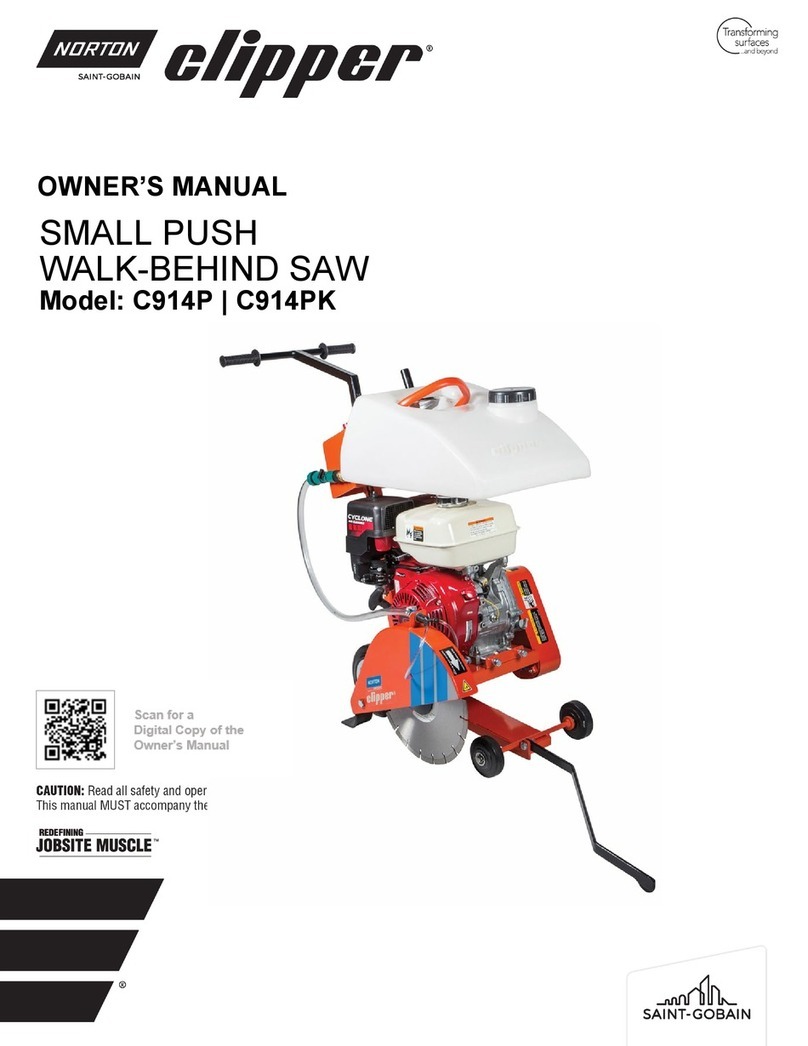
Norton Clipper
Norton Clipper C914P User manual
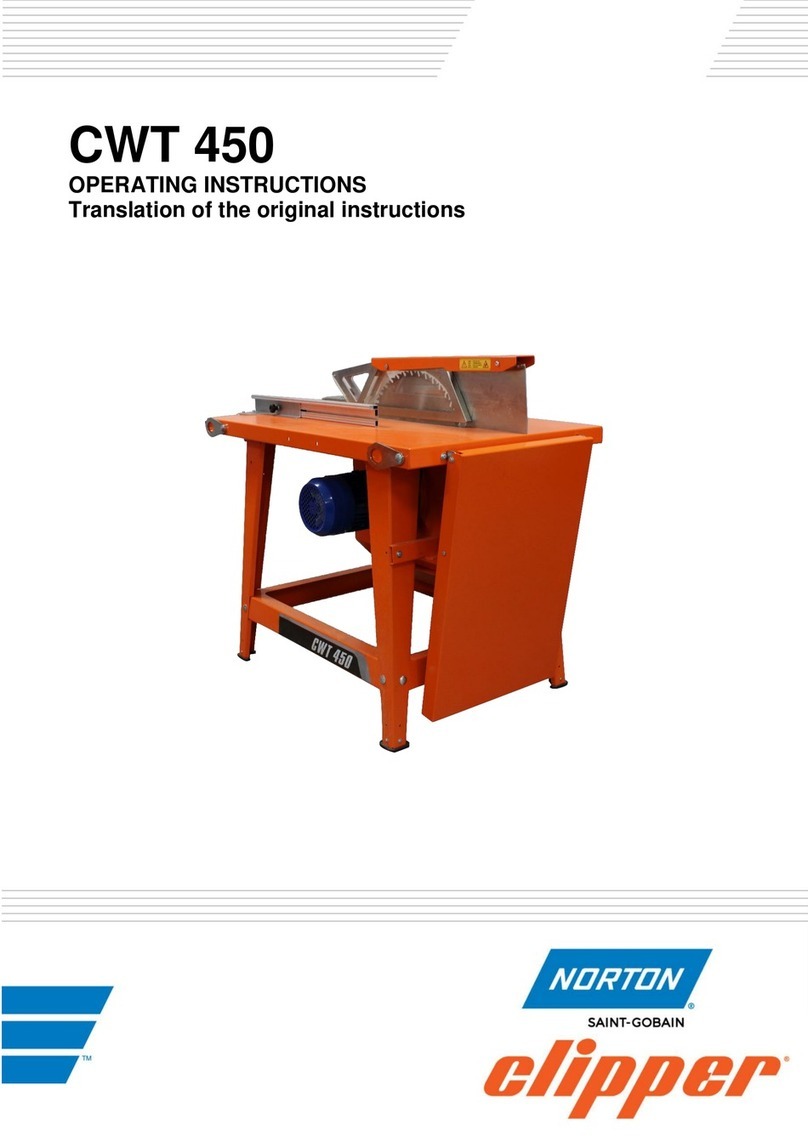
Norton Clipper
Norton Clipper CWT 450 User manual
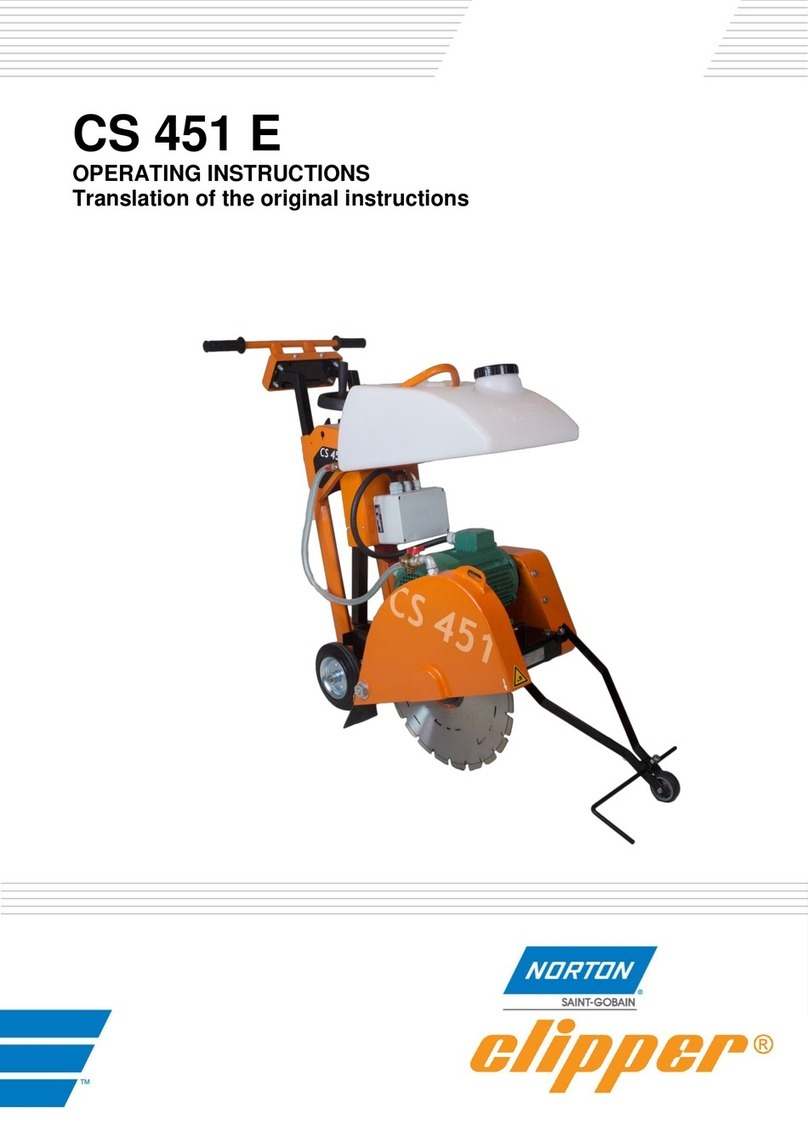
Norton Clipper
Norton Clipper CS 451 E User manual
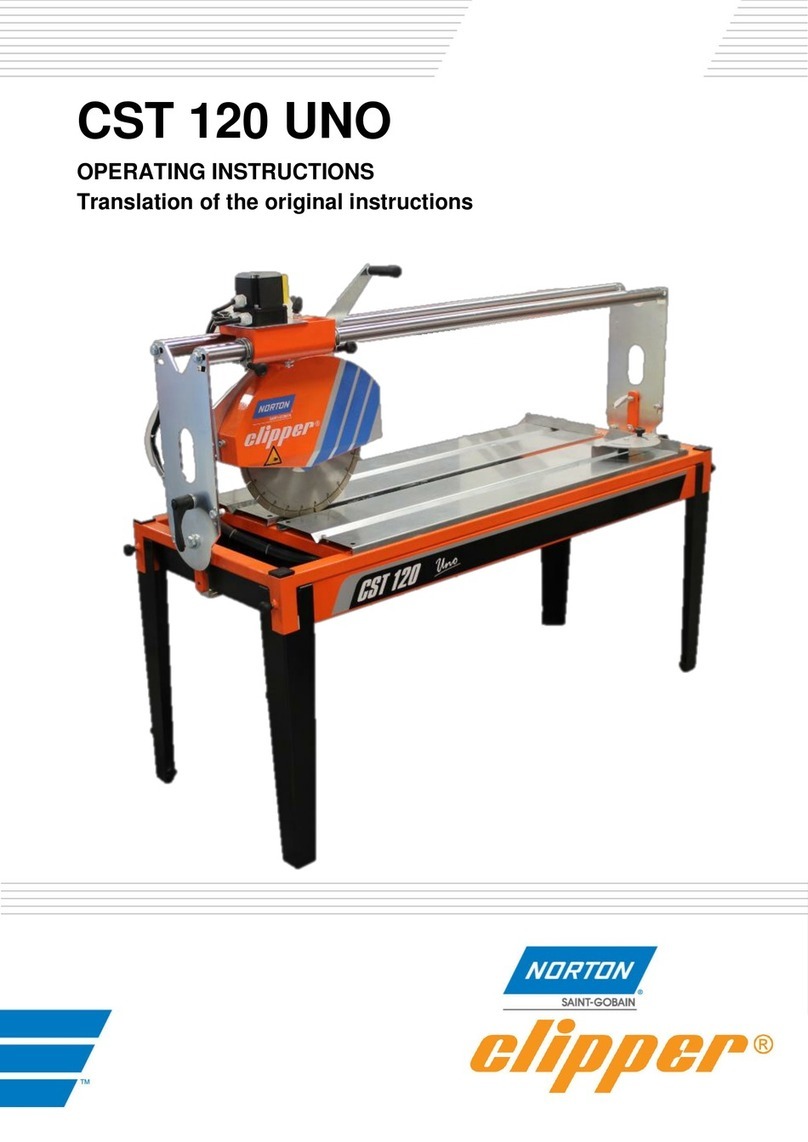
Norton Clipper
Norton Clipper CST 120 UNO User manual
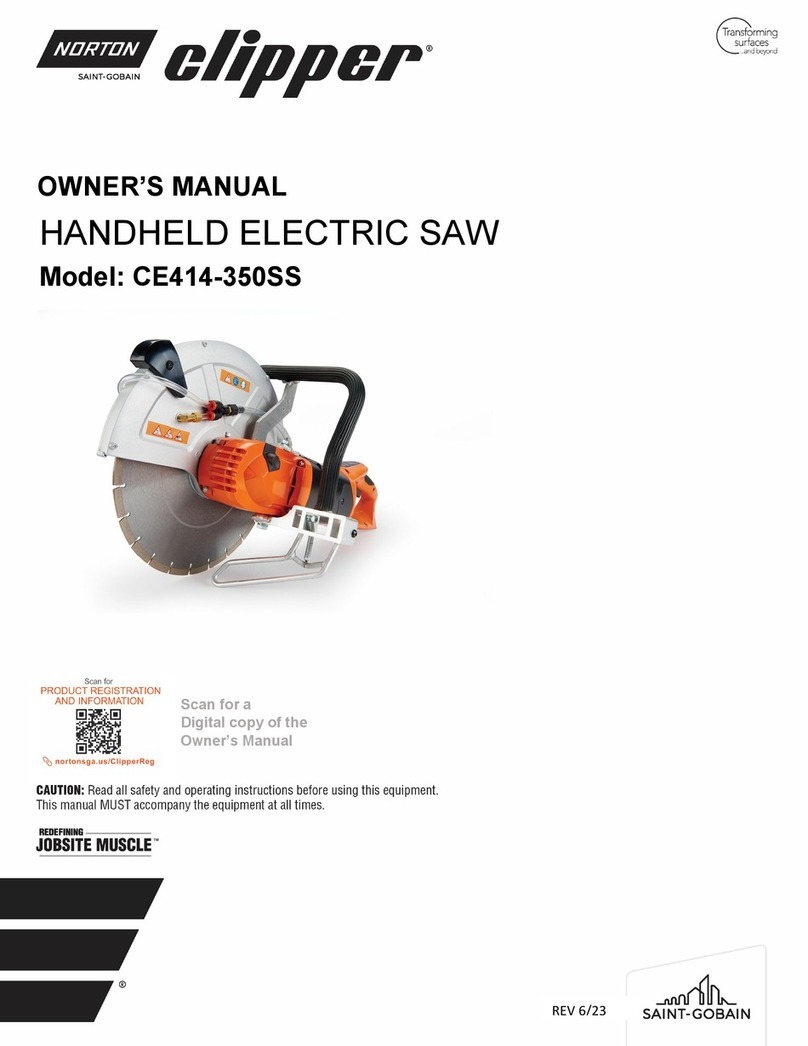
Norton Clipper
Norton Clipper CE414-350SS User manual
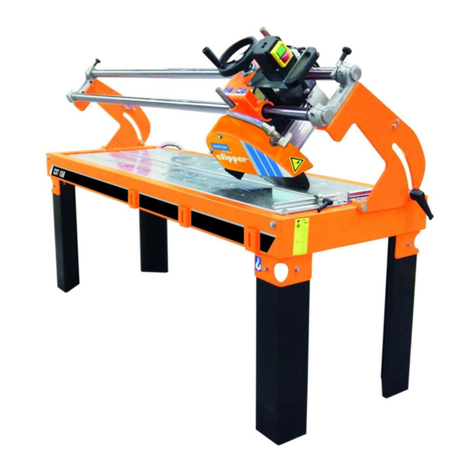
Norton Clipper
Norton Clipper CST 100 User manual

Norton Clipper
Norton Clipper CM 601 User manual
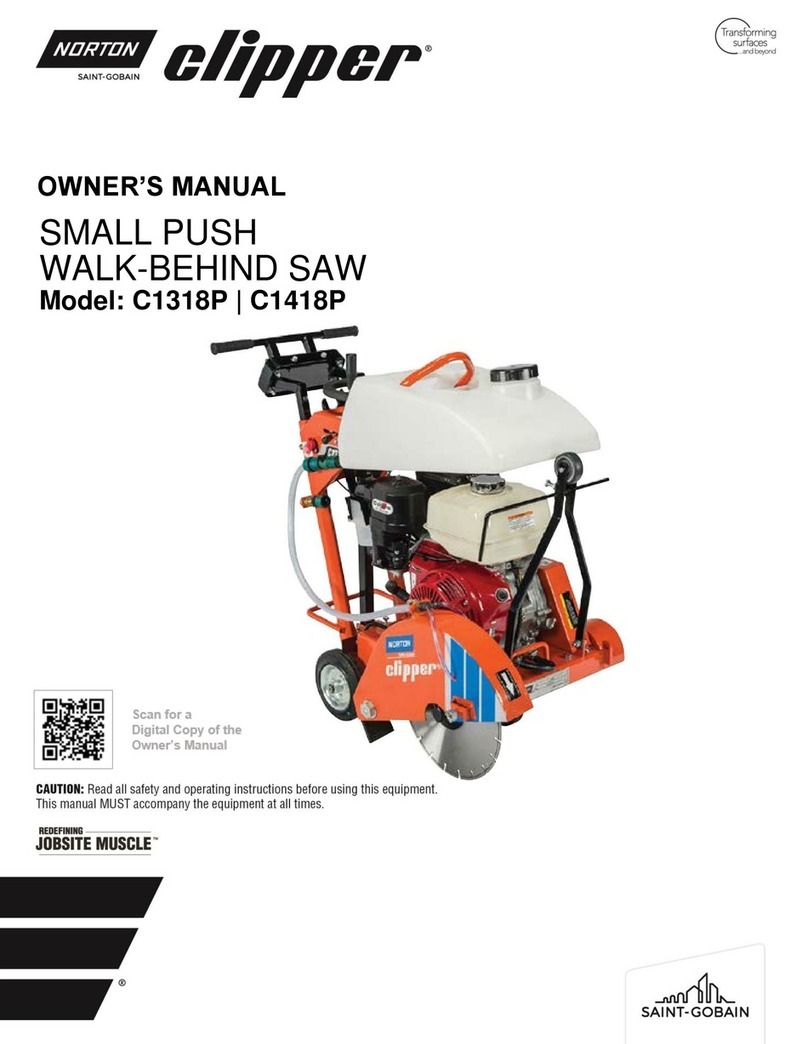
Norton Clipper
Norton Clipper C1318P User manual

Norton Clipper
Norton Clipper CE414-350 User manual
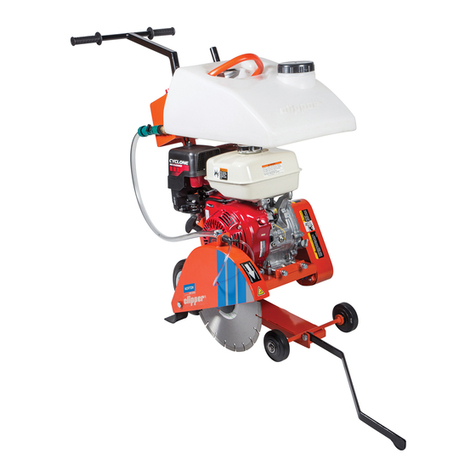
Norton Clipper
Norton Clipper C914P User manual

